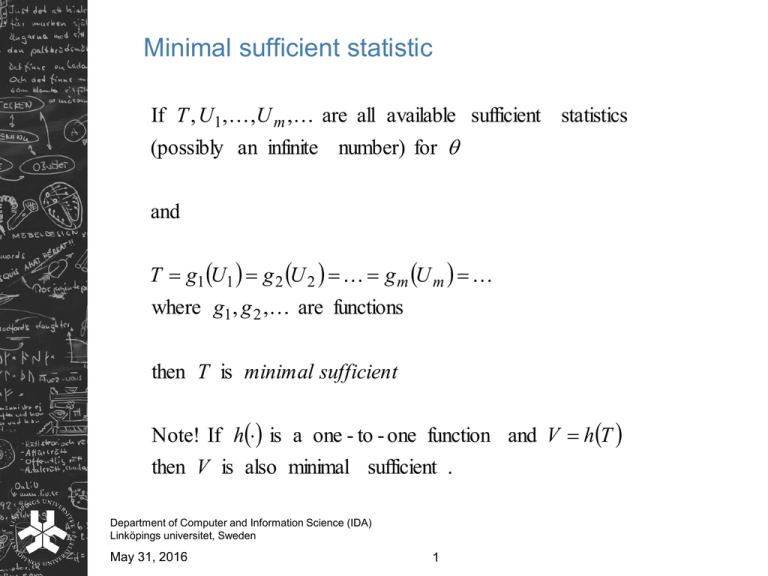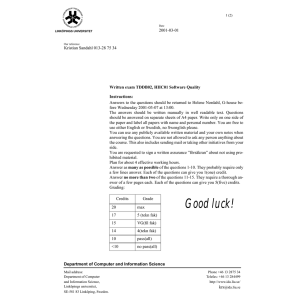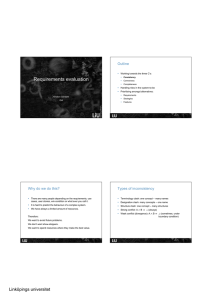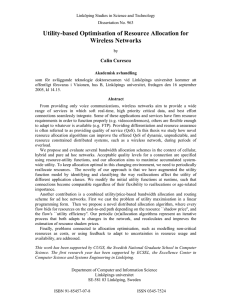Minimal sufficient statistic
advertisement

Minimal sufficient statistic If T , U1 , , U m , are all available sufficient statistics (possibly an infinite number) for and T g1 U1 g 2 U 2 g m U m where g1 , g 2 , are functions then T is minimal sufficient Note! If h is a one - to - one function and V hT then V is also minimal sufficient . Department of Computer and Information Science (IDA) Linköpings universitet, Sweden May 31, 2016 1 A statistic defines a partition of the sample space of (X1, … , Xn ) into classes satisfying T(x1, … , xn ) = t for different values of t. If such a partition puts the sample x = (x1, … , xn ) and y = (y1, … , yn ) into the same class if and only if L ; x does not depend on L ; y then T is minimal sufficient for Department of Computer and Information Science (IDA) Linköpings universitet, Sweden May 31, 2016 2 Example Assume again x x1 , , xn is a sample from Exp n Let T X 1 , , X n X i and let T x1 , , xn t T y1 , , yn i 1 i.e. y y1 , , yn belongs to the same class as x L ; x e i1 xi n e 1T x1 ,, xn L ; y e i1 yi n e 1T y1 ,, yn 1 n 1 n n n L ; x e 1 T x1 ,, xn T y1 ,, y n n 1T y ,, y e 1 n L ; y e n 1T x1 ,, xn e 1 t t 1 not depending on T is minimal sufficient for Department of Computer and Information Science (IDA) Linköpings universitet, Sweden May 31, 2016 3 Rao-Blackwell theorem Let x1 , , xn be a random sample from a distributi on with p.d.f f x; Let T be a sufficient statistic for and ˆ an unbiased point estimator of Let ˆT E ˆ T Then 1) ˆT is a function of T alone 2) E ˆ 3) Var ˆ Var ˆ T T Department of Computer and Information Science (IDA) Linköpings universitet, Sweden May 31, 2016 4 The Exponential family of distributions A random variable X belongs to the (k-parameter) exponential family of probability distributions if the p.d.f. of X can be written A 1 ,, k B j x C x D 1 ,, k j 1 j f x;1, , k e k where A1, , Ak and D are functions of 1, , k alone B1, , Bk and C are functions of x alone What about N(, 2 ) ? Po( ) ? U(0, ) ? Department of Computer and Information Science (IDA) Linköpings universitet, Sweden May 31, 2016 5 For a random sample x = (x1, … , xn ) from a distribution belonging to the exponential family n L1 , , k ; x e j1 A j 1 ,, k B j xi C xi D 1 ,, k k i 1 e i1 j1 A j 1 ,, k B j xi C xi D 1 ,, k e j1 A j 1 ,, k i1 B j xi i1C xi nD 1 ,, k e j1 A j 1 ,, k i1 B j xi nD 1 ,, k n k k k n n n C x e i1 i n K1 in1 B1 xi , , in1 Bk xi ;1 , , k K 2 x1 , , xn T in1 B1 xi , , in1 Bk xi is sufficient for 1 , , k In addition T is minimal sufficient (Lemma 2.5) Department of Computer and Information Science (IDA) Linköpings universitet, Sweden May 31, 2016 6 Exponential family written on the canonical form: Let 1 A1 1 , , k , , k Ak 1, , k the so - called natural or canonical parameters k B x C x D* 1 ,,k j 1 j j f x; 1 , , k e where D* 1, , k D1 , , k Department of Computer and Information Science (IDA) Linköpings universitet, Sweden May 31, 2016 7 Completeness Let x1, … , xn be a random sample from a distribution with p.d.f. f (x; )and T = T (x1, … , xn ) a statistic Then T is complete for if whenever hT (T ) is a function of T such that E[hT (T )] = 0 for all values of then Pr(hT (T ) 0) = 1 Important lemmas from this definition: Lemma 2.6: If T is a complete sufficient statistic for and h (T ) is a function of T such that E[h (T ) ] = , then h is unique (there is at most one such function) Lemma 2.7: If there exists a Minimum Variance Unbiased Estimator (MVUE) for and h (T ) is an unbiased estimator for , where T is a complete minimal sufficient statistic for , then h (T ) is MVUE Lemma 2.8: If a sample is from a distribution belonging to the exponential family, then (B1(xi ) , … , Bk(xi ) ) is complete and minimal sufficient for 1 , … , k Department of Computer and Information Science (IDA) Linköpings universitet, Sweden May 31, 2016 8 Maximum-Likelihood estimation Consider as usual a random sample x = x1, … , xn from a distribution with p.d.f. f (x; ) (and c.d.f. F(x; ) ) The maximum likelihood point estimator of is the value of that maximizes L( ; x ) or equivalently maximizes l( ; x ) Useful notation: ˆML arg max L ; x With a k-dimensional parameter: θˆML arg max Lθ; x θ Department of Computer and Information Science (IDA) Linköpings universitet, Sweden May 31, 2016 9 Complete sample case: If all sample values are explicitly known, then ˆML n n arg max f xi ; arg max ln f xi ; i 1 i 1 Censored data case: If some ( say nc ) of the sample values are censored , e.g. xi < k1 or xi > k2 , then ˆML n nc nc ,l nc ,u arg max f xi ; Pr X k1 Pr X k 2 i 1 where nc,l Number of values known only as being below k1 (left - censored) nc,u Number of values known only as being above k 2 (right - censored) nc,l nc,u nc Department of Computer and Information Science (IDA) Linköpings universitet, Sweden May 31, 2016 10 When the sample comes from a continuous distribution the censored data case can be written ˆML n nc nc ,l nc ,u arg max f xi ; F k1 ; 1 F k 2 ; i 1 In the case the distribution is discrete the use of F is also possible: If k1 and k2 are values that can be attained by the random variables then we may write ˆ ML n nc arg max f xi ; F k1 ; i 1 1 F k nc ,l 2 ; nc ,u where k1 is a value k1 but the attainable value closest t o the left of k1 k2 is a value k2 but the attainable value closest t o the right of k2 Department of Computer and Information Science (IDA) Linköpings universitet, Sweden May 31, 2016 11 Example x x1 , , xn random sample (R.S.) from the Rayleigh distributi on with p.d.f. f x; x ex 2 2 , x 0 , 0 xi2 x x 2 2 n l ; x ln e ln xi ln i 1 i 1 n 1 n 2 ln xi n ln xi n i 1 l n 1 2 i 1 l n 1 x ; 0 2 i 1 n 2 i 1 n 2 xi (case 0 excluded) n i 1 Department of Computer and Information Science (IDA) Linköpings universitet, Sweden May 31, 2016 12 n x i 1 2 i 2l n 2 n 2 2l 2 3 xi 2 2 i 1 n3 2 xi2 i 1 1 n 2 1 n 2 ˆ xi defines a (local) maximum ML xi n i 1 n i 1 n 1 n i 1 xi2 xi2 i 1 2 2n 3 n Department of Computer and Information Science (IDA) Linköpings universitet, Sweden May 31, 2016 13 n n3 xi2 i 1 n 2 0 Example x 4,3,5,3, " 5" R.S. from the Poisson distributi on with p.d.f. (mass function) f x; x e x! One of the sample values is right - censored : x5 5 ˆML 4 arg min f xi ; Pr X 5 i 1 4 arg min ln f xi ; ln Pr X 5 i 1 Department of Computer and Information Science (IDA) Linköpings universitet, Sweden May 31, 2016 14 4 xi y y arg min ln e ln e i 1 xi ! y 6 y! y 5 4 arg min xi ln ln xi ! ln 1 e i 1 y 0 y! Too complicated to find an analytical solutions. Solve by a numerical routine! Department of Computer and Information Science (IDA) Linköpings universitet, Sweden May 31, 2016 15 Exponential family distributions: Use the canonical form (natural parameterization): * B x C x D j j k f x; e j1 Let n T j X B j X i , j 1, , k i 1 and assume T j x t j , j 1, , k Then the maximum likelihood estimators (MLEs) of 1, … , k are found by solving the system of equations E T j X t j , j 1, , k Department of Computer and Information Science (IDA) Linköpings universitet, Sweden May 31, 2016 16 Example x x1 , , xn R.S. from the Poisson distributi on f x; x e e x ln ln x! x! f x; , i.e. ln x ln x! e e n Bx x T X X i i 1 MLE is found by solving n n n n E X i xi E X i xi i 1 i 1 i 1 i 1 Department of Computer and Information Science (IDA) Linköpings universitet, Sweden May 31, 2016 17 E X i x f x; x e x 0 e x x 1 x ln x! e x e x! e x 1 y x 1 e y 0 e x x 1! e y y! e e n n n i 1 i 1 i 1 e x 0 e e e 1 e e xi ne xi e x Department of Computer and Information Science (IDA) Linköpings universitet, Sweden May 31, 2016 18 e x 1 x! x 1! e x 1 ˆML ln x e x x e e e Computational aspects When the MLEs can be found by evaluating l 0 θ numerical routines for solving the generic equation g( ) = 0 can be used. • Newton-Raphson method Fisher’s method of scoring (makes use of the fact that under regularity conditions: • l θ; x l θ; x 2l θ; x E E θi j i j ) This is the multidimensional analogue of Lemma 2.1 ( see page 17) Department of Computer and Information Science (IDA) Linköpings universitet, Sweden May 31, 2016 19 When the MLEs cannot be found the above way other numerical routines must be used: • Simplex method • EM-algorithm For description of the numerical routines see textbook. Maximum Likelihood estimation comes into natural use not for handling the standard case, i.e. a complete random sample from a distribution within the exponential family , but for finding estimators in more nonstandard and complex situations. Department of Computer and Information Science (IDA) Linköpings universitet, Sweden May 31, 2016 20 Example x1 , , xn R.S. from U a, b b a 1 a x b f x; a, b otherwise 0 b a n a x1 x2 xn b La, b; x otherwise 0 La, b; x is as largest () when b a (degenerat ed case). No local maxima or minima exist. Department of Computer and Information Science (IDA) Linköpings universitet, Sweden May 31, 2016 21 La, b; x is maximized with respect t o the sample when b a is as small as possible Choose the smallest possible approximat ion of b and the largest possible approximat ion of a from the values in the sample bˆML xn and aˆ ML x1 Department of Computer and Information Science (IDA) Linköpings universitet, Sweden May 31, 2016 22 Properties of MLEs Invariance: If θ and φ represent two alternativ e parameteri zations and φ is a one - to - one function of θ : φ g θ θ hφ, then if θˆ is the MLE of θ g θˆ is the MLE of φ Consistency: Under some weak regularity conditions all MLEs are consistent Department of Computer and Information Science (IDA) Linköpings universitet, Sweden May 31, 2016 23 Efficiency: Under the usual regularity conditions: ˆML is asymptotic ally distribute d as N , I1 (Asymptotically efficient and normally distributed) Sufficiency: ˆML unique MLE for ˆML is a function of the minimal sufficient statistic for Department of Computer and Information Science (IDA) Linköpings universitet, Sweden May 31, 2016 24 Example x R.S. from N , 2 2 x 1 f x; , 2 2 2 e x 2 2 x 2 ln ln 2 2 2 e 2 2 2 x 1 1 ln 2 ln 2 2 2 2 e 2 2 1 1 2 2 2 x 2 x ln 2 ln 2 2 2 2 e 2 1 2 2 n n 2 n 2 x 2 xi ln 2 ln 2 2 2 2 e 2 1 2 i L , 2 ; x 1 1 2 and 2 2 ; T1 X X i2 and T2 X X i 2 Department of Computer and Information Science (IDA) Linköpings universitet, Sweden May 31, 2016 25 1 E T1 X E X n n 22 21 n E T2 X E X i n n 22 2 21 ˆ and ˆ are obtained by solving 2 i 1, ML 2 2 2 , ML 1 22 n 2 xi2 21 41 n 2 xi 21 Department of Computer and Information Science (IDA) Linköpings universitet, Sweden May 31, 2016 26 2 1 22 n 2 2 41 1 1 21 x 2 2 2 21 x n x i 2 41 21 1 1 2 1 2 ˆ x n xi 1, ML 2 1 2 2 x n xi 21 1 2 2 n 1 xi x ˆ 2 , ML 1 2 2 n 1 x x 2 i Department of Computer and Information Science (IDA) Linköpings universitet, Sweden May 31, 2016 27 x x 2 1 n x x i Invariance property 1 2 has a one - to - one relationsh ip with 2 (as the system of relating equations has a unique solution) 2 ˆ ML 1 2ˆ n 1 xi x 2 1, ML 2 ˆ ML ˆ ML ˆ2, ML x 2 Note! bias ˆ ML 0 but 0 as n Department of Computer and Information Science (IDA) Linköpings universitet, Sweden May 31, 2016 28 1 l , ; x 2 2 n n 2 n 2 xi ln 2 ln 2 2 2 2 2 x i 2 2 l 1 n 2 xi 2 l 2l 2 2 1 2 2l 2 2 2 2 xi 2 2 n 2 2 2 2 2 1 xi 2 n 1 2 2 2 x i 3 2 2 2 2 3 xi Department of Computer and Information Science (IDA) Linköpings universitet, Sweden May 31, 2016 n n 2 2l 2 x i 2 2 29 n n 2 2 2 2 2 3 l , 2 ; x 2l , 2 ; X n E 2 2 2l , 2 ; x 1 n E n 0 2 2 2 2 2 2l , 2 ; x 1 2 n 2 2 E n n 2 3 2 3 2 2 22 n 2 with θ , 2 22 n 2l , 2 ; x 2 I θ E 2 θ 0 0 n 4 2 Department of Computer and Information Science (IDA) Linköpings universitet, Sweden May 31, 2016 30 n 2 2 2 3 I θ1 I θ , 2, 2 1 det I θ I θ , 2,1 2 n 0 n 4 I θ ,1, 2 1 2 n n I θ ,1,1 0 0 0 2 4 2 0 n 2 0 2 4 n 2 ˆ ML 2 is asymptotic ally distribute d as N 2 ; n ˆ ML 0 0 2 4 n i.e. the two MLEs are asymptotically uncorrelated (and by the normal distribution independent) Department of Computer and Information Science (IDA) Linköpings universitet, Sweden May 31, 2016 31 Modifications and extensions Ancillarity and conditional sufficiency: T T1 X , T2 X a minimal sufficient statistic for θ θ1 , θ2 a) fT2 t depends on θ2 but not on θ1 b) fT1 T2 t T2 t 2 depends on θ1 but not on θ2 T2 is said to be an ancillary statsitic for θ1 and T1 is said to be conditionally independent of θ2 Department of Computer and Information Science (IDA) Linköpings universitet, Sweden May 31, 2016 32 Profile likelihood: With θ θ1, θ2 and Lθ1, θ2 ; x , if θˆ2.1 is the MLE of θ2 for a given val ue of θ1 then L θ1, θˆ2.1; x is called the profile likelihood for θ1 This concept has its main use in cases where 1 contains the parameters of “interest” and 2 contains nuisance parameters. The same ML point estimator for 1 is obtained by maximizing the profile likelihood as by maximizing the full likelihood function Department of Computer and Information Science (IDA) Linköpings universitet, Sweden May 31, 2016 33 Marginal and conditional likelihood: Lθ1 , θ2 ; x is equivalent to the joint p.d.f. of the sample x , i.e. f X x; θ1 , θ2 If u, v is a partitioni ng of x then f X x; θ1 , θ2 f X u,v; θ1 , θ2 Now, if f X u,v; θ1 , θ2 can be factorized as f1 u; θ1 f 2 v u; θ1 , θ2 and f 2 v u; θ1 , θ2 does not depend on θ1 , then inferences about θ1 can be based solely on f1 u; θ1 , the marginal likelihood for θ1. If f X u,v; θ1 , θ2 can be factorized as f1 u v; θ1 f 2 v; θ1 , θ2 , then inferences about θ1 can be based solely on f1 u v; θ1 , the conditiona l likelihood for θ1. Again, these concepts have their main use in cases where 1 contains the parameters of “interest” and 2 contains nuisance parameters. Department of Computer and Information Science (IDA) Linköpings universitet, Sweden May 31, 2016 34 Penalized likelihood: MLEs can be derived subjected to some criteria of smoothness. In particular this is applicable when the parameter is no longer a single value (one- or multidimensional), but a function such as an unknown density function or a regression curve. The penalized log-likelihood function is written l P θ; x l θ; x Rθ where Rθ is the penalty function and is a fixed parameter controllin g the influence of Rθ . is thus not estimated by maximizing l P θ; x , but can be estimated by so - called cross - validation techniqu es (see ch. 9) Note that x is not the ususal random sample here, but can be a set of independen t but non - identicall y distribute d values Department of Computer and Information Science (IDA) Linköpings universitet, Sweden May 31, 2016 35 Method of moments estimation (MM ) For a random variable X : The rth population moment about the origin is r E X r The rth population moment about the mean (rth central moment) is r' E X 1 r Department of Computer and Information Science (IDA) Linköpings universitet, Sweden May 31, 2016 36 For a random sample x x1 , , xn : The rth sample moment about the origin is n mr n 1 xir i 1 The rth sample moment about the mean is n mr' n 1 xi x r i 1 Department of Computer and Information Science (IDA) Linköpings universitet, Sweden May 31, 2016 37 The method of moments point estimator of = ( 1, … , k ) is obtained by solving for 1, … , k the systems of equations r mr , r 1, , k or r' mr' , r 1, , k or a mixture between t hese two Department of Computer and Information Science (IDA) Linköpings universitet, Sweden May 31, 2016 38 Example x x1 , , xn R.S. from U a, b ab 2 Second central moment : 2' 2 E X 2 2 First moment about the origin : 1 2 2 3 3 1 a b y b a b a a b y2 dy ba 4 4 3b a 4 3b a a a b 2 3 b a b 2 ab a 2 a 2 2ab b 2 3b a 4 b 4b 2 4ab 4a 2 3a 2 6ab 3b 2 12 12 2 b 2 2ab a 2 b a 12 12 Department of Computer and Information Science (IDA) Linköpings universitet, Sweden May 31, 2016 39 Solve for a, b the systems of equations ab x 2 b a 2 ˆ 2 n 1 n x x 2 i 12 i 1 2 2 x 2a b 2x a 12 ˆ 2 x a 3ˆ 2 2 x a 3ˆ 2 a x 3ˆ 2 a x 3ˆ 2 b 2 x x 3ˆ 2 x 3ˆ 2 not possible since a b aˆ MM x 3ˆ 2 bˆMM x 3ˆ 2 Department of Computer and Information Science (IDA) Linköpings universitet, Sweden May 31, 2016 40 Method of Least Squares (LS) First principles: Assume a sample x where the random variable Xi can be written X i m i where m is the mean valu e (function) involving and i is a random variable with zero mean and constant variance 2 The least-squares estimator of is the value of that minimizes n 2 x m i i 1 i.e. ˆLS n 2 arg min xi m i 1 Department of Computer and Information Science (IDA) Linköpings universitet, Sweden May 31, 2016 41 A more general approach Assume the sample can be written (x, z ) where xi represents the random variable of interest (endogenous variable) and zi represent either an auxiliary random variable (exogenous) or a given constant for sample point i X i m ; zi i where E i 0 , Var i i2 and Cov i , j cij with i2 , cij possibly functions of zi , z j The least squares estimator of is then ˆLS arg min εT Wε where ε 1 , , n and W is the variance - covariance matrix of ε Department of Computer and Information Science (IDA) Linköpings universitet, Sweden May 31, 2016 42 Special cases The ordinary linear regression model: X i 0 1 z1,i p z p ,i i Zβ ε with W 2 I n and Z is considered to be a constant matrix n βˆ LS arg min i2 β i 1 1 T n 2 T arg min xi 0 1 z1,i p z p ,i Z Z Z x β i 1 The heteroscedastic regression model: X i Zβ ε with W 2I n T 1 1 T ˆ β LS Z W Z Z W 1 x Department of Computer and Information Science (IDA) Linköpings universitet, Sweden May 31, 2016 43 The first-order auto-regressive model: X t X t 1 t , W 2I n Let x x1, x2 , , xn and z *, x1, , xn1 , i.e. for the first sample point (first ti me - point) z is not available X t zt t , t 2, , n Department of Computer and Information Science (IDA) Linköpings universitet, Sweden May 31, 2016 44 The conditional least-squares estimator of (given ) is ˆCLS n 2 n 2 arg min i arg min xi zi i 2 i 2 arg min ε T W1ε T 0 0 n 1 and 0 where W1 n 1 is the n 1 - dimensiona l 0 n1 I n1 0 vector of zeros 0 Department of Computer and Information Science (IDA) Linköpings universitet, Sweden May 31, 2016 45






